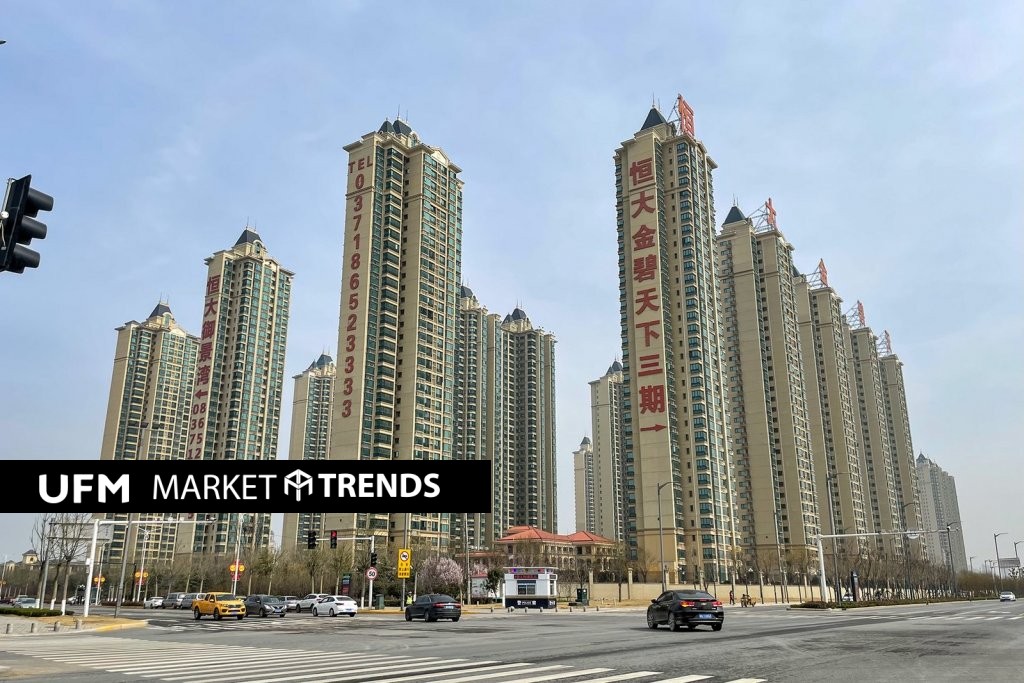The Case of Evergrande: Is There a Housing Bubble in China?

China has made the world’s capital markets nervous. Evergrande, the largest real estate developer in China and one of the largest in the world, is on the ropes. It is very likely it will go bankrupt (it has already defaulted on some interest payments on its bonds). Some people are debating whether this is the “Chinese Lehman Brothers.” Are we on the verge of a new global financial collapse?
This article is the first in a series that will analyze the case of Evergrande, from its financial health to its possible contagion effects on the rest of the world economy.
Let’s begin by analyzing the health of the sector in which Evergrande finds itself. What is the state of the housing sector in China? The purpose of this article is to determine whether there are signs of a housing bubble there.
The Chinese Housing Bubble and Empty Cities
The existence of a housing bubble in China has been reported on for over a decade. The primary evidence is the existence of ghost cities (that is, cities that are practically empty). For over ten years, ghost cities have not appeared to be causing a systemic problem (although they undoubtedly pose a local problem). However, the vacancy rate has continued to grow in China in secondary cities (and in some major cities, such as Beijing, the vacancy rate has reached 20 percent).
China’s housing vacancy rate is relatively high when compared with other countries, although in 2017 it was lower than that of Spain and Italy.
Taken by themselves, the data on the vacancy rate are not alarming. However, when this indicator (and the existence of ghost cities) is combined with other indicators, the Chinese housing sector’s situation does indeed look alarming.
Housing-Price/Rental-Price Ratio
Housing is a durable capital good and as such must be valued. How is the price of a capital good determined? The most common way is to base it on the income the good is capable of generating.[1] In the case of housing, the income it generates is the rent (either through the market or through the rental payments the owner avoids). Accordingly, it is crucial that the value of the house be a reasonable multiple of the rental value.[3]
The housing-price/rental-price ratio gives a sense of how inflated a housing market is. When the indicator is very high, purchasing a house cannot be justified by the income it will generate. The only reason someone will buy a house in this case is if they hope to sell it for a higher price (and if everyone operates on the same expectation, we are facing a bubble by definition).
The housing-price/rental-price ratio in the Chinese real estate market is incredibly high; in fact, it is exceeded only by the real estate market in Turkey and Taiwan. Purchasing a home in China and renting it out is a very poor business plan, as it takes a whopping forty-eight years to recoup the investment.
The Profitability of Purchasing a House
The profitability of investing in housing can be analyzed in a similar manner. The income of a house is divided by the house’s sales price. The result (once costs are deducted) is the profitability of investing in the housing sector. An analysis reveals that investment in real estate in Chinese cities is less profitable than in cities almost anywhere else.
Further, the returns from investing in China’s housing market are much lower than the country’s prevailing mortgage interest rate. So purchasing a house in China does not make economic sense. This is a clear sign of a housing bubble.
Homes’ Purchase Price versus Citizens’ Median Income
Another way of analyzing whether the housing market is in a bubble is to determine whether the average citizen can buy a home. The main purpose of a house is to be lived in (final demand). If the price of housing grows well above the purchasing power of the average citizen, the demand for housing (which drives the price growth) may well turn out to be purely speculative and collapse in the future when it becomes clear that the final demand does not exist.[5]
China’s ratio of housing price to per capita income is the second highest in the world (behind only India’s). It would take the average Chinese citizen 146 years to pay for a home if they were to devote all of their income to housing.[6]
The previous indicator could be problematic as a means of comparing countries since it relates national per capita income to the price of urban housing (despite this, it is worth discussing it because of the huge contrast between China and other countries). If we disaggregate the indicator by city, we reach the same conclusion: the price of housing is too high relative to the income of Chinese inhabitants.
The Housing Sector’s Contribution to GDP
Another way to assess whether the Chinese housing market is in a bubble is to look at the housing sector’s contribution to GDP. A high contribution indicates too many resources are allocated to housing. This indicator is the logical corollary of those discussed above: if house prices are high, producers react by increasing supply, in the process drawing resources from other parts of the economy.
The contribution of China’s housing sector to its GDP is greater than the corresponding contribution seen in the huge Irish and Spanish housing bubbles of the 2000s. Nearly a third of China’s economic activity is linked to bricks.
The Disproportionate Concentration of Wealth in Housing
Another sign of a bubble is the concentration of wealth and investment in a single sector. Real estate is a favorite investment among Chinese citizens. The recent increase in the income and quality of life of Chinese citizens has exponentially increased their ability to save and invest. The asset in which they invest has almost exclusively been real estate. In 2018, 76 percent of Chinese household wealth was invested in housing (in Japan this figure is 41 percent, and in the United States it is 27.7 percent).
The concentration of assets in the housing market makes Chinese households vulnerable to shocks in that market. As Rogoff and Yang (2021) point out, the valuation of the Chinese housing market today is double the valuation of the US housing market, even though China’s GDP is 25 percent lower than the United States’. In the Japanese housing bubble that burst in the 1990s, exactly the same thing was seen (the market valuation at the peak was double that of the US housing market).
The huge demand for housing assets is generating a housing supply far greater than the housing needs of Chinese citizens (a typical bubble trait). In 2008, only 30 percent of new housing was bought by people who already possessed at least one home; in 2018, this figure was 88 percent.
Chinese Authorities Want to Burst the Bubble
The problems discussed here are so evident that the Communist Party leadership have taken action. They have implemented relatively restrictive financial measures such as debt ratios and capital requirements for housing developers. These measures have meant that the most financially irresponsible developers are prohibited from increasing their debt by even a single yuan. They precipitated Evergrande’s problems (to be examined in a subsequent article).
The Chinese authorities see that there is a housing bubble and that something needs to be done.
Conclusion
The Chinese housing bubble is enormous; various economic indicators leave no room for doubt. Evergrande’s problem is not an isolated issue but a systemic problem with the Chinese economy.
In a future article, we will analyze the financial health of what was once China’s largest real estate developer but is now on the verge of bankruptcy.
Legal notice: the analysis contained in this article is the exclusive work of its author, the assertions made are not necessarily shared nor are they the official position of the Francisco Marroquín University.
-
Notes
[1] Specifically, future flows must be discounted at a rate that includes a time premium and a risk premium. The discounted amount is the net present value.
[2] Avoiding a cash outflow is the financial principle of quasi-income.
[3] That the multiple is reasonable means that it is not very different from the multiple in other economic activities, always weighted by the risk in a particular market (otherwise arbitrage is possible).
[4] With complementary investment, a house can be adapted for other uses such as office space (although in many jurisdictions such a change requires changing the house’s legally designated use and paying the attendant fee).
[5] Lack of demand at the expected price is enough to cause the bubble to burst (that is, there could be final demand for housing at much lower prices).
[6] Per capita income is not synonymous with income per worker.
Get our free exclusive report on our unique methodology to predict recessions

Daniel Fernández
Daniel Fernández is the founder of UFM Market Trends and professor of economics at the Francisco Marroquín University. He holds a PhD in Applied Economics at the Rey Juan Carlos University in Madrid and was also a fellow at the Mises Institute. He holds a master in Austrian Economics the Rey Juan Carlos University and a master in Applied Economics from the University of Alcalá in Madrid.
Get our free exclusive report on our unique methodology to predict recessions



The analysis of China’s housing market is indeed concerning. The indicators presented clearly point towards a housing bubble, which has substantial implications not only for the Chinese economy but potentially for the global financial landscape as well. The high housing-price/rental-price ratio, the lack of profitability in housing investments, and the disproportionate concentration of wealth in real estate all underscore the fragility of the market.
The fact that the Chinese authorities have recognized the issue and implemented measures to address it highlights the severity of the situation. Evergrande’s struggles are symptomatic of a larger problem within the Chinese economy. It will be crucial to monitor how these developments unfold, as they could have significant repercussions on both domestic and international financial markets.